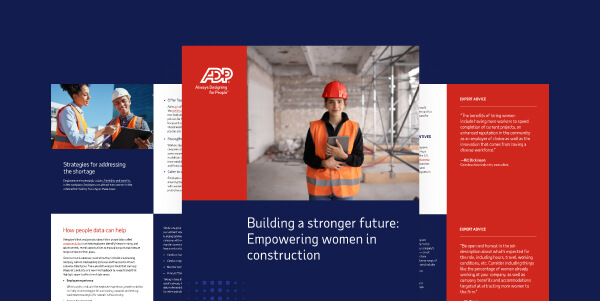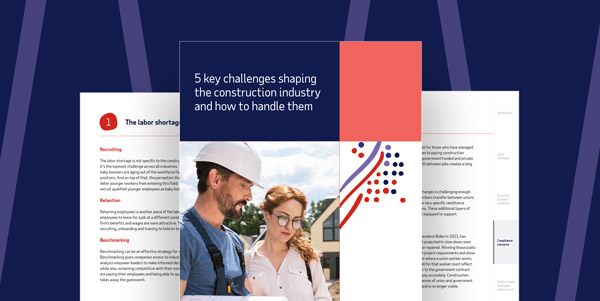All-in-one construction payroll and HR software
The construction industry has unique demands for payroll and HR: calculating accurate job costing for your labor, compliance with union contracts and government regulations and staffing your jobs in a tight labor market. Simplify how you manage it all with intuitive solutions built for the construction industry.
Already using ADP? Sign in or get support.

See why over 20,000 construction companies choose ADP
From certified payroll and HR management to labor tracking and compliance reporting, ADP has the solutions to
help you stay productive, manage risk, and control costs — wherever you are.
Compensation Benchmarking Included in ADP Workforce Now
See how your organization compares to industry benchmarks
Tap into insights from a data pool of over 42 million employees to answer crucial questions like:
- Is our pay competitive with similar organizations in our area?
- How does our overtime compensation compare to other organizations like ours?
- Do our compensation packages help attract and retain top talent?

Transform your HR processes with ADP Marketplace
ADP clients can easily find, try, buy and build solutions to help streamline how they manage HR and run their business.
Buy New HR Solutions
Apps for Your Business
Find, try and buy apps to help solve your biggest HR challenges, including time & labor management, recruitment & onboarding, compliance, and more.

Connect HR systems
Pre-Built Integrations
Automatically and securely connect your employee data between ADP and your existing HR software — with no coding or IT help needed. Quickly integrate ADP with popular solutions for recruiting, time-tracking, benefits and more.
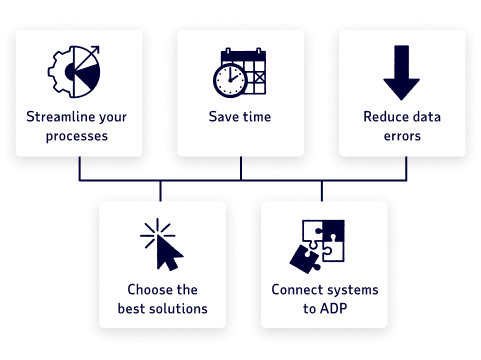
Build custom integrations
Data Integration Made Easy
Securely integrate your ADP worker data with your HR and business systems. ADP API Central gives developers instant access to the ADP APIs, tools and resources they need to quickly and easily build a customized HCM ecosystem.
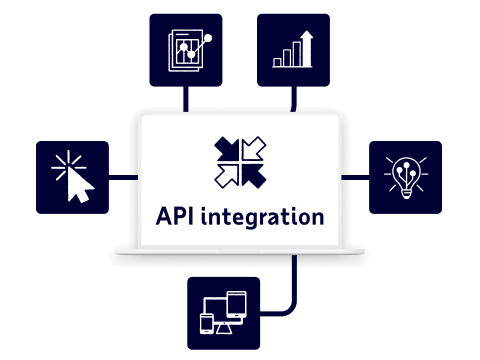
ADP Workforce Now® for Construction
Finally, an HCM software built for construction
Unify your payroll and HR in one integration solution. ADP Workforce Now for Construction is a leading all-in-one HCM solution built for construction to address the complexities of your industry.

ADP® Construction Center
of Excellence
Offered as a part of ADP Workforce Now®, the Construction Center of Excellence (CCOE) helps your manage all your HR and payroll-related needs – starting with implementation through ongoing specialized service that covers payroll, taxes, compliance, reporting, and more.
- Dedicated, expert and centralized support for your construction-specific payroll needs.
- Get up and running efficiently with guided set-up and onboarding help from construction-focused implementation associates.
- Support for prevailing wages, unions, job costing, and certified payroll reporting, and more.
Take a self-guided demo
Click through our self-led demo to see how easy payroll and HR can be.
Select your business size to get started. Select your business size to
try a demo today.
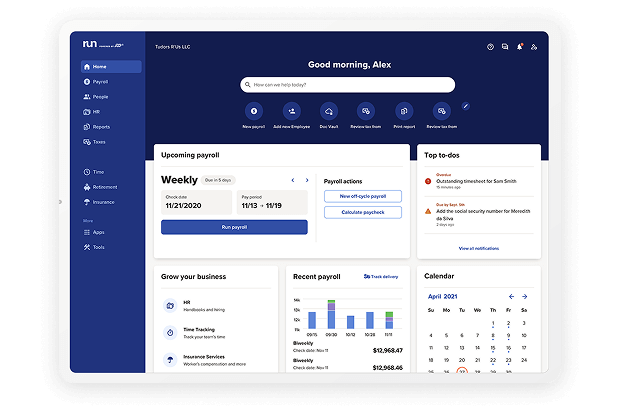
Get the right online payroll services for your business
See packages for your business size
Essential Payroll
Perfect for startups and established companies that simply need payroll, taxes, and compliance they can trust.
Enhanced Payroll
Adds powerful capabilities on top of payroll, such as garnishment payment service, SUI management, background checks, and job posting through ZipRecruiter®1.
Complete Payroll & HR+
Includes ADP’s latest HR tools such as live HR support, employee handbook wizard, proactive compliance alerts, HR guidance and forms, and a job description wizard.
HR Pro Payroll & HR
Offers a comprehensive suite of HR tools such as a proactive HR support team, employer/employee training, business advice, and legal assistance from Upnetic Legal Services®2.
Plus
Everything included in our "Select" package and streamline benefits administration with time-saving technology.
Premium
Everything included in our "Plus" package and automated time-tracking with Time and Attendance.
Trusted by construction companies like you
MEET OUR CLIENTS
We saved about $750,000 just as a result of the reduction in turnover that first year. It allows us to invest into other things to help us grow, and as we continue to reduce turnover, the cost savings year over year will be over $1 million.
JR Richards Executive Vice President of Talent Resources, Ewing Irrigation

MEET OUR CLIENTS
As the owner of a small business, I wear pretty much all the hats. So, I’m looking at everything I can do to make my job as stress-free as I can, to focus on my business. With ADP, I’m saving money because I don’t have to pay an extra salary for someone to do all this.
Joel Hardy Founder and CEO, Hardy Tile & Stone

MEET OUR CLIENTS
ADP Workforce Now’s workflow process allows us to see the modules in action so we can review and approve items across different departments without having to re-enter data. These modules save me time by putting hours back in my day so I can focus on strategy instead of repetitive data entry.
Marilyn Milby HR & Safety Generalist, Associated Asphalt Partners LLC

Explore our resources
Construction payroll and HR FAQs
How do you keep track of construction employees’ hours?
If you’re a contractor or in the construction industry, you can keep track of your employees’ hours using either paper timesheets and punch clocks or mobile time tracking apps that have GPS and geofencing capabilities. Digital solutions make it easier to track employees on multiple job sites, thereby minimizing the risk of mistakes.
How do you do construction accounting?
Construction accounting requires an understanding of basic accounting practices – debits, credits, financial statements, etc. – as well as job costing, which helps manage the many variables of running a project-based business. A construction payroll service that is capable of paying employees across multiple states and unions may also be helpful, especially if you want to save time.
What is a construction cost report?
A construction cost report is a detailed summary of all of the costs associated with a specific project, including labor. Tracking this data allows project managers to monitor actual labor costs against budgeted amounts and make informed decisions to ensure the project stays on budget.
How do you control costs on construction projects?
Tracking the physical completion of a job across milestones can help control construction project costs. When the first milestone is achieved, look at your material, labor and overhead expenses. If these costs went above what was originally forecast, you can correct the issues that caused the overage in successive milestones and bring the project back within budget. Another way to control costs is to spread overhead expenses among multiple jobs that might use the same equipment.


* Available features will depend on the ADP solution(s) purchased
- ZipRecruiter is a registered trademark of ZipRecruiter, Inc.
- Legal services are provided by Upnetic Legal Services, a third-party provider







